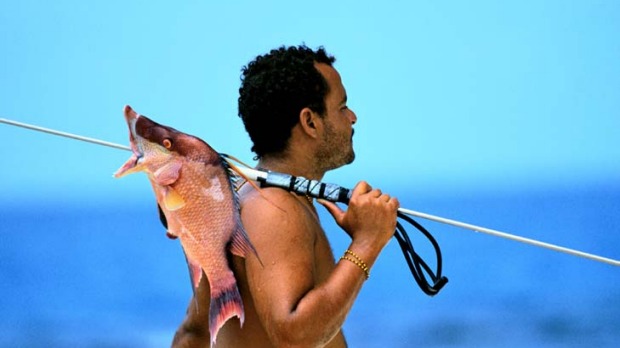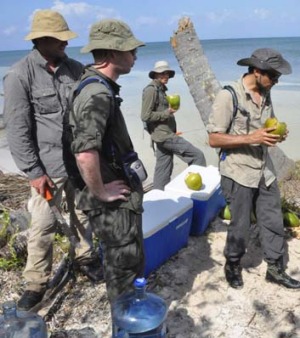
'Marooned' on a desert island, Graeme Green learns to fend for himself using machetes and plastic bags.
THE signal comes from the front. The helicopter is going down: we have to jump. I step out onto the skid, then take another step into air. Seconds later, I'm in the Caribbean Sea, swimming for a small patch of sand between thick mangrove trees on a nearby island. Water fills my boots and makes my clothes heavy which, along with the current, means progress is slow. I wade onto the beach, closely followed by my fellow "survivors".
This is what we've trained for. For the past five days, we've sailed the blue waters around remote Turneffe Atoll, 40 kilometres off the coast of Belize, setting up rudimentary camps on deserted beaches to learn the essentials of island survival.

The staged emergency exit from the helicopter marks the start of our "isolation phase", in which our group will have to put what we've learned into practice, unsupervised. With aircon and cooling cocktails, these islands might be paradise. But without such comforts as beds, food, water or relief from the intense heat, these are inhospitable environments where survival depends on our ability to find or produce food, water, shelter and fire from our unpromising surroundings.
We were warned it would be tough. "The whole point is to make you psychologically uncomfortable," instructor Ian Craddock told us on day one. "This is not happy camping." He's a former SAS instructor and a mate of Bear Grylls and Bruce Parry, and the desert island survival course he's put together is refreshingly light on health and safety hang-ups. ("Here's a speargun - point it at what you want to hit and shoot.")
It is also full of genuine hardships and tests of character. Not to be undertaken lightly.
We're in troubled waters from the start: when we set off from Caye Caulker at the beginning of our week's training phase, the sea is so rough that even hardened captain Papa Joe looks perturbed. We spend our first night on a sandy strip of shore lined with gnarly, sun-bleached tree trunks.
Our team is, disappointingly, all male - I've never particularly enjoyed exclusively male company. But it's a good group and in the course of the week the eight of us - including an Austrian hypnotist, an American web marketer and an aeroplane engineer, whose face peels, bleeds and peels again in the sun, making him look like Freddy Krueger's Welsh cousin - form a tight unit.
We spend mornings on the beach learning how to make and start a fire, how to build a shelter, how to scale, gut and cook fish. Ian demonstrates how to use a machete with a 36-centimetre blade: it's a vital piece of kit that can help provide food (opening coconuts, for example), water and shelter.
Real survival is a world away from TV survival, he stresses: "There are no fancy tricks, no squeezing water from cow poo. It's simple - all you need to do is stay alive."
We learn techniques that produce small but life-saving quantities of fresh water: if you wrap plastic bags around palm tree leaves, they "sweat" and the water vapour condenses and collects at the bottom of the bag. We find and hack open coconuts for the water and flesh inside.
The sun is relentless, the intense heat exhausting. Water is rationed. Food is basic and limited. But the worst thing by far, an absolute drain on spirits and morale, are the bugs.
Mosquitoes and flies pester us from the moment we land. They make simple tasks difficult and unpleasant and they disturb our sleep, in hammocks under our makeshift shelter. (There's talk of scouting out a group of islands further south for next year's trips, to reduce the problem.)
A few days in, my body is covered in itchy red bumps.
But there's great satisfaction, too, in learning new skills and in stripping life down to the essentials. The island demands assertiveness. We have to be alert and think ahead because what we do or don't do has direct consequences on, say, our food or water supplies. And in the moments when the bugs are kept at bay by campfires, I enjoy the beauty of our remoteness. There are pink sunsets that make the tropical sky glow, campfires on sandy beaches under crescent moons, mornings swimming alone in the clear sea.
The best parts of the day come when we are out on the boat and diving to catch dinner. I've never speargunned for fish before but find I have a knack for it, bringing in a good share of the group's evening meals. I engage in epic chases over coral landscapes with parrotfish and snapper.
There's a Last Supper-ish feel to the night before "isolation". Ian has deliberately withheld information so that we're unprepared but we know it will be tough. Not everyone completes these courses; some radio in for an early rescue from whatever torment breaks them.
After the helicopter has dropped us from a height of eight metres into the sea and we've swum to shore, we inspect our survival kit - a dinghy and speargun, plastic bags for collecting water, a first aid kit and two machetes - and survey our surroundings.
We are surprisingly efficient. Four of us build a wooden structure with a roof of palm tree fronds. Others collect firewood and coconuts. We set up plastic bags on green leaves and dig solar stills to start the slow process of collecting water. By early afternoon, we're sheltering from the sun in our roomy "hut".
The speargun turns out not to be much use. We go out on the dinghy but there's no reef close to the island on which to fish. (The fish hide in the mangroves close to the island, Ian later tells us.) We manage to keep fires burning through the night but the insects are still a major annoyance and, with no beds or hammocks, no one gets much sleep. I spend most of the night by the campfire trying to stay warm, feeding the flames with coconut husks and tree branches.
The following day, the group is sapped of energy. Tony (ex-British Army) manages to catch a few small crabs and cooks them on the fire. We eat the minuscule amounts of white flesh but mostly live, Papillon-style, on coconut. Ian checked in briefly the night before, dropping off a few small fish and a bottle of water as rewards for our good work (a cheat but a welcome one). But we are all hungry, thirsty, tired, itchy from our bites and drained by the heat. We collect wood to keep the fire burning but otherwise spend lethargic hours in our shelter.
Time slows, which is both a blessing and a curse. There's time here to think and to talk. We have long philosophical discussions about memory, sexuality, sport, the history of mankind. The group's camaraderie maintains our vital PMA (Positive Mental Attitude, the top tier in the army's triangle of survival needs). There are filthy jokes, games of hangman and I-spy. Inevitably, conversations find their way back to the cold beers and junk food that await us back on Caye Caulker after rescue. This thought sustains us.
But mostly, "isolation" is a test of mental fortitude and the capacity to endure discomfort. Rescue can't come quickly enough.
We keep the fires burning through another difficult night and early in the morning sit together, chewing on small chunks of coconut, watching through a gap in the mangroves for the small yellow boat that will carry us away from the island. When it comes, we board quickly. Relief passes through our bodies, each one of us bearded, dirty, exhausted but alive.
Getting there
Belize city is a two-hour flight from Miami, Florida. Qantas flies to Miami via Los Angeles, code-sharing with American Airlines, qantas.com.au.
Surviving there
Desert island survival courses cost $1944 a person. Next courses are February 2-11 and 16-26, and March 1-10 next year. bushmasters.co.uk.